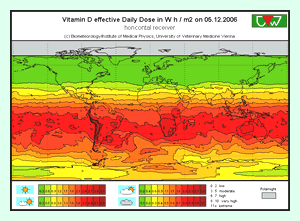 |
||||||||||
Updated: August 9, 2025
The Vitamin D3 Debate Continues
Dermatologists and Other Cancer Experts Examine the Data for Clues
Topics Alert No. 186 Updates the Picture
 The picture is hardly clear as the skin cancer risks to CLL patients are viewed against the demonstrated health benefits (including the ability to fight cancers and infections) of sun exposure through the action of Vitamin D3. However, medically supervised supplementation with the active form of this vitamin (cholecalciferol) can still be combined with prudent management of sun exposure to provide most of the benefits of this important mainenance drug. Our Alert #186: the Vitamin D3 Debate Continues, brings you up to date on the debate.
The picture is hardly clear as the skin cancer risks to CLL patients are viewed against the demonstrated health benefits (including the ability to fight cancers and infections) of sun exposure through the action of Vitamin D3. However, medically supervised supplementation with the active form of this vitamin (cholecalciferol) can still be combined with prudent management of sun exposure to provide most of the benefits of this important mainenance drug. Our Alert #186: the Vitamin D3 Debate Continues, brings you up to date on the debate.
Those Aches and Pains
The Effects of a Hidden Deficiency May be Wrongly Blamed on CLL
Topics Alert No. 47 Identifies an Available Fix for What Possibly Ails You
 One of the common mistakes we (and our doctors!) make is attributing everything that goes wrong to CLL — things such as muscle pains and the aches in our bones. You could be suffering from something that can be very easily corrected, a real cheap fix. Not only does it not cost a lot, it is not even toxic (isn't that a welcome change from the usual caveats with chemo drugs?), and it might even help you fight the CLL. But don't do this without medical supervision — overdosing is only too easy and can have lethal consequences. What is this drug? It is called vitamin D3. Read Topics Alert Number 47, titled Those Pesky Aches and Pains for some interesting pointers.
One of the common mistakes we (and our doctors!) make is attributing everything that goes wrong to CLL — things such as muscle pains and the aches in our bones. You could be suffering from something that can be very easily corrected, a real cheap fix. Not only does it not cost a lot, it is not even toxic (isn't that a welcome change from the usual caveats with chemo drugs?), and it might even help you fight the CLL. But don't do this without medical supervision — overdosing is only too easy and can have lethal consequences. What is this drug? It is called vitamin D3. Read Topics Alert Number 47, titled Those Pesky Aches and Pains for some interesting pointers.
Vitamin D3: Essential for Health
Dosages, Cautions and the Need for Monitoring
Effective Supplementation Can Help Fight Cancer
 Vitamin D is a very potent regulator of cellular biochemistry. We review the research literature on the value of an adequate intake of Vitamin D3 in maintaining general health and in fighting cancer. The literature indicates that the officially recommended dosage (RDA) of the vitamin is barely enough to avoid deficiency diseases and woefully inadequate to provide the multiple health benefits available from this supplement. However, any aggressive supplementation regimen must be carefully monitored and medically supervised since high dosages can lead to systemic toxicity (hypercalcemia) and even death. Our review article, “Vitamin D3: Essential for Health” explores the benefits, raises the caution flags and explains how to benefit from the vitamin without the risk of sun exposure.
Vitamin D is a very potent regulator of cellular biochemistry. We review the research literature on the value of an adequate intake of Vitamin D3 in maintaining general health and in fighting cancer. The literature indicates that the officially recommended dosage (RDA) of the vitamin is barely enough to avoid deficiency diseases and woefully inadequate to provide the multiple health benefits available from this supplement. However, any aggressive supplementation regimen must be carefully monitored and medically supervised since high dosages can lead to systemic toxicity (hypercalcemia) and even death. Our review article, “Vitamin D3: Essential for Health” explores the benefits, raises the caution flags and explains how to benefit from the vitamin without the risk of sun exposure.
External Resource
World class Experts Help to Nail Down the Facts
The Vitamin D Council
 The Vitamin D Council is a well-organized website with comprehensive information on the topic, presented in a straightforward way that patients can understand. The experts behind this organization have impressive credentials. Please do visit this site and read the material presented to decide for yourself whether Vitamin D3 supplementation should be a part of your regimen. The material on their website can certainly provide you with authoritative background to start a conversation with your own doctor(s).
The Vitamin D Council is a well-organized website with comprehensive information on the topic, presented in a straightforward way that patients can understand. The experts behind this organization have impressive credentials. Please do visit this site and read the material presented to decide for yourself whether Vitamin D3 supplementation should be a part of your regimen. The material on their website can certainly provide you with authoritative background to start a conversation with your own doctor(s).
The following are short articles on Vitamin D3, presented most recent first.
Autoimmune Diabetes
Vitamin D3 as Therapy
Date: April 29, 2025
by Chaya Venkat
It is a fact of life with CLL that there are a number of dangerous autoimmune diseases that seem to thrive in the same patient population. Autoimmune diabetes (type 1) is one of the more dangerous complications of an immune system gone crazy, attacking the wrong cells and letting the cancer cells live unharmed. In the case of autoimmune diabetes, it is the insulin producing islet beta cells of the pancreas that are attacked and killed. Unlike more garden variety diabetes, this has little to do with being obese, or eating too many sweet things and being a couch potato.
A couple of weeks ago I wrote about the potential value of several new Vitamin D3 analogues as possible drugs in treatment of cancers of all types, including CLL. Below is an interesting report on a slightly different use, Vitamin D3 analogues as possible treatment for autoimmune diabetes. Please allow me to sound the same cautionary note here as I did in the previous article on Vitamin D3: it is the most toxic of all the vitamins if ingested at greater than required levels. One of the side effects of Vitamin D toxicity is hypercalcemia, which can be potentially fatal. The moral of the story is that Vitamin D3 therapy is not, repeat, not your average do-it-yourself therapy. Having said that, it is encouraging that scientists are now coming up with many different synthetic versions of Vitamin D3 that appear to have many of the desired qualities, with fewer of the toxic side effects.
These are developments worth watching.
BioXell SpA
26/04/2002 11:19:53 Europe/Roma
Vitamin D3 Analogue Arrests the Development of Autoimmune Diabetes
Milano, Italy, April 26, 2025 - BioXell SpA announced today the publication of a study in the May issue of the journal Diabetes describing the ability of a synthetic analogue of the active form of vitamin D3 (1,25-dihydroxyvitamin D3) to arrest the development of autoimmune diabetes (type 1 diabetes) in non-obese diabetic (NOD) mice. This study is the first to demonstrate the ability of a selected vitamin D3 analogue to block ongoing diabetes in the adult NOD mouse, a model that closely resembles the pathogenesis of human type 1 diabetes.
"The demonstration that ongoing autoimmune diabetes can be arrested by a relatively short treatment of a vitamin D3 analogue in adult NOD mice suggests that a similar treatment may also inhibit disease progression in pre-diabetic or newly diagnosed type 1 diabetes patients," said Dr Luciano Adorini, Chief Scientific Officer of BioXell and director of the study. "The mechanism of action of this analogue is particularly intriguing because inhibition of disease is associated with an increased frequency of a cell subset in pancreatic lymph nodes, that has recently been demonstrated to have a regulatory role in humans."
The paper, entitled "A 1a,25-Dihydroxyvitamin D3 Analogue Enhances Regulatory T Cells and Arrests Autoimmune Diabetes in NOD Mice," demonstrates that this particular analogue inhibits diabetes development without inducing toxic side effects. There is an unmet clinical need for a safe drug that inhibits disease progression and does not rely on exogenous insulin administration, given the very severe complications associated with this disease. Vitamin D3 analogues have been shown to inhibit autoimmune diseases in several animal models, including autoimmune diabetes, but the compounds tested so far show efficacy in NOD mice with ongoing disease only if combined with strong immunosuppressive agents, like cyclosporine A.
This particularly potent analogue, which embodies 20 years of research, was designed and synthesised by Milan Uskokovic, VP for Chemistry at BioXell Inc., a subsidiary of BioXell located in Nutley, NJ. Dr Uskokovic, a co-author of the paper, developed Rocaltrol, the first Vitamin D3 analogue to enter the market.
About BioXell BioXell is a private research and development biopharmaceutical company with a competitive edge in immunology developing two strong technology platforms based on the TREM receptor system and Vitamin D3 analogues. From these, BioXell has identified molecules to be developed in secondary hyperparathyroidism, benign prostatic hyperplasia, as well as research programmes in type 1 diabetes, transplantation and psoriasis. In March 2025, BioXell raised Euro22m in a first-round financing from a consortium of three top-tier venture capital firms: MPM Capital, Index Ventures and Life Science Partners. BioXell has a network of academic collaborations, including Washington University, St. Louis and the Universities of Arkansas, Milan, Florence, Modena and Zurich.
For further information, please contact:
BioXell SpA
Francesco Sinigaglia
Chief Executive Officer
Tel. +39.02.2884 803
Alvise Sagramoso
Chief Administrative Officer
Tel. +39.02.2884 803
Noonan Russo Presence
Veronica Cefis Sellar
Tel. +44.20.7726 4452
Margherita Forlenza
Tel. +44.20.7726 4452
______________

Therapy for CLL
Vitamin D3 analog EB1089
Date: March 17, 2025
by Chaya Venkat
And here is the abstract of the article regarding vitamin D3 analog that Dr. Grever referred to in his paper "In Pursuit of a Complete Remission". The URL to the Vitamin D3 article is given below.
PLENARY PAPER: Blood, 1 April 2025, Vol. 101, No. 7, pp. 2454-2459
Blood Journal Absract
The vitamin D3 analog EB1089 induces apoptosis via a p53-independent mechanism involving p38 MAP kinase activation and suppression of ERK activity in B-cell chronic lymphocytic leukemia cells in vitro
Chris Pepper, Alun Thomas, Terry Hoy, Donald Milligan, Paul Bentley, and Chris Fegan
From the Departments of Haematology, Llandough Hospital, Penarth, Vale of Glamorgan; University of Wales College of Medicine, Cardiff; and Birmingham Heartlands Hospital, United Kingdom.
EB1089, a novel vitamin D3 analog, has been shown to have cytotoxic and antiproliferative properties in a variety of malignant cells. However, its potential as a treatment for B-cell chronic lymphocytic leukemia (B-CLL) has not been evaluated. EB1089 induced apoptosis in all of the 102 B-CLL samples tested with a mean LD50 (the concentration of EB1089 required to kill 50% of cells) value (± SD) of 2.1 × 108 M (± 1.4 × 108 M). Furthermore, no significant difference was found in the cytotoxicity of EB1089 in B-CLL samples from previously treated and untreated patients (P = .1637). Induction of apoptosis was associated with a reduction in Bcl-2 and Mcl-1 protein expression, but this was evident only in the apoptotic cells. In contrast, the expression of Bax, p21, and p53 was not altered in the viable or apoptotic cells from either B- or T-lymphocyte lineages. EB1089-induced apoptosis was preceded by activation of p38 mitogen-activated protein (MAP) kinase and suppression of extracellular signal-regulated kinase (ERK) activity, and this was associated with downstream activation of caspase-3. The pancaspase inhibitor (Z-VAD-FMK) and the caspase-9 inhibitor (Z-LEHD-FMK) were able to partially abrogate the apoptotic effects of EB1089 but did not affect the phosphorylation of p38 MAP kinase or the suppression of ERK. The B-CLL cells in the study were shown to highly express vitamin D receptor, but an additional receptor-independent mechanism of cell killing cannot be ruled out at this stage. These findings show that EB1089 is a potent apoptosis-inducing agent in B-CLL cells and may be useful in the treatment of B-CLL patients, particularly those with p53 mutations or drug-resistant disease.
© 2025 by The American Society of Hematology.
___________

New Therapy
Vitamin D3 Analog as Cancer Fighter
Date: March 3, 2025
by Chaya Venkat
Vitamin D is one of those essential dietary substances necessary for life. This vitamin regulates the absorption of calcium by the body, and therefore controls proper bone development. More recently, around 1980, it was discovered that in addition to its role in calcium uptake, it also controls and regulates the proliferation and differentiation of a variety of cells, including cancer cells. The problem with using it as an anti-proliferation cancer drug is that in anything other than the minute quantities required for normal functioning of the body, it is quite toxic, causing over-absorption of calcium, a condition known as hypercalcemia.
The search has been going on for a number of years, looking for an analog of Vitamin D, that has the high affinity for Vitamin D Receptors (VDRs) on cells, but with minimized calcium regulation effects. Looks like some progress is being made on this front, the abstracts below detail development and testing of a new version of Vitamin D, code named EB1089 for now.
The second abstract below describes testing of EB1089 with a large variety of CLL cells. CLL cells were found to express high levels of VDRs, and EB1089 was able to induce apoptosis (cell death) at very low concentrations. What makes it even more interesting was that there was no difference in efficacy between previously treated and untreated patients, or on the presence or deletion of the all important p53 anti-cancer gene. In other words, it (or some newer and better version of it) may prove to work equally well with poorer prognosis patients, those who have been through prior therapy and those with p53 deletion.
These are early results. But if the trend continues in development of low toxicity and more tolerable vitamin D analogs like this one, I think there is hope that indolent diseases like CLL may someday be maintained indefinitely in remission, with very few side effects or loss of quality of life.
J Nutr Biochem 2025 May;13(5):252-264
Vitamin D and cancer.
Mehta RG, Mehta RR.
Department of Surgical Oncology, University of Illinois, College of Medicine, 840 South Wood Street (M/C 820), 60612, Chicago, IL
Vitamin D, a steroid hormone and exerts its biological effects through its active metabolite 1alpha, 25 dihydroxyvitamin D3 [1,25(OH) 2D3]. Like steroid hormones, 1,25(OH)2D3 is efficacious at very low concentrations and serves as a ligand for vitamin D receptors (VDR), associating with VDR very high affinity. Despite its potent property as a differentiating agent, its use in the clinical practice is hampered by the induction of hypercalcemia at a concentration required to suppress cancer cell proliferation. Therefore nearly 400 structural analogs of vitamin D3 have been synthesized and evaluated for their efficacy and toxicity. Among these analogs, relatively less toxic but highly efficacious analogs, EB1089, RO24-5531, 1alpha- hydroxyvitamin D5 and a few others have been evaluated in a preclinical toxicity and in Phase I clinical trials for dose tolerance in advanced cancer patients. Clinical trials using vitamin D analogs for prevention or therapy of cancer patients are still in their infancy. Vitamin D mediates its action by two independent pathways. Genomic pathway involves nuclear VDR and induces biological effects by interactions with hormone response elements and modulation of differential gene expressions. Evidence also suggests that vitamin D analogs also interact with steroid hormone(s) inducible genes. The non-genomic pathway is characterized by rapid actions of vitamin D. It involves interactions with membrane-VDR interactions and its interactions with protein kinase C and by altering intracellular calcium channels. Thus, the development of nontoxic analogs of vitamin D analogs and understanding of their molecular mechanism(s) of action are of significant importance in the prevention and treatment of cancer by vitamin D.
PMID: 12015155
____________
Blood 2025 Nov 21
The vitamin D3 analog, EB1089, induces apoptosis via a p53-independent mechanism involving p38 MAP kinase activation and suppression of ERK activity in B-cell chronic lymphocytic leukemia cells in vitro.
Pepper C, Thomas A, Hoy T, Milligan D, Bentley P, Fegan C.
Department of Haematology, Llandough Hospital, Penarth, United Kingdom.
EB1089, a novel vitamin D3 analog, has been shown to have cytotoxic and anti-proliferative properties in a variety of malignant cells. However, its potential as a treatment for B-cell chronic lymphocytic leukemia (B-CLL) has not been evaluated. EB1089 induced apoptosis in all of the 102 B-CLL samples tested with a mean LD50 value (+/-SD) of 2.1 (+/- 1.4) x 10(-8) M. Furthermore, no significant difference was found in the cytotoxicity of EB1089 in B-CLL samples from previously treated and untreated patients (p = 0.1637). Induction of apoptosis was associated with a reduction in Bcl-2 and Mcl-1 protein expression but this was only evident in the apoptotic cells. In contrast, the expression of Bax, p21 and p53 were not altered in the viable or apoptotic cells from either B- or T-lymphocyte lineages. EB1089- induced apoptosis was preceded by activation of p38 MAP kinase and suppression of ERK activity and this was associated with downstream activation of caspase-3. The pan-caspase inhibitor (Z-VAD-FMK) and the caspase-9 inhibitor (Z-LEHD-FMK) were able to partially abrogate the apoptotic effects of EB1089 but did not affect the phosphorylation of p38 MAP kinase or the suppression of ERK. The B-CLL cells in the study were shown to highly express vitamin D receptor but an additional receptor-independent mechanism of cell killing cannot be ruled out at this stage. These findings show that EB1089 is a potent apoptosis-inducing agent in B-CLL cells and may be useful in the treatment of B-CLL patients particularly those with p53 mutations or drug resistant disease.
PMID: 12446453
____________
 Enter Keywords: |
———
Disclaimer: The content of this website is intended for information only and is NOT meant to be medical advice. Please be sure to consult and follow the advice of your doctors on all medical matters.
Copyright Notice:
Copyright © 2025-2007 CLL Topics, Inc. All Rights Reserved.
All materials contained on this site are protected by United States copyright law and may not be reproduced, distributed, transmitted, displayed, published or broadcast without the prior written permission of CLL Topics, Inc. You may not alter or remove any trademark, copyright or other notice from copies of the content.
However, you may download and print material from CLLTopics.org exclusively for your personal, noncommercial use.
———
